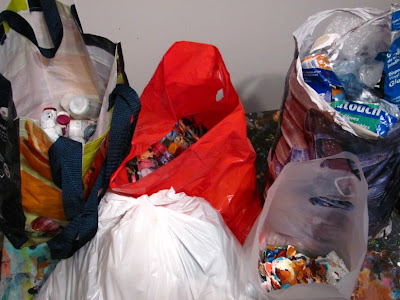I wish you could have seen my studio last week. Well, maybe I don’t. The state of it can only be described as “explosive.” A very intense year limited my time to mainly producing, and not so much to maintaining a well organized clutter-free space. Add to that, my process leans toward the “messy” side of things. Paper bits, cleaning tissues, ink pots, wash splatter, end up all over.
It has been 11 months since the last big clean/organization and I am in dire need of a refreshed space.
Although my process is, as I mentioned, messy, it is also a process which does not require a large amount of paint, paint being the one item used in my studio with the highest capability of adversely impacting health and environment through its production, properties, and disposal.
From Non Toxic Paint & Print:
"Acrylic polymer paints are safer than oil paints, primarily due to the absence of toxic solvents. No reproducible adverse health effects have been associated with the use of acrylic polymer mediums. Like all water soluble paints, however, acrylics contain preservatives (usually formaldehyde in small amounts)."
The advantage to a once yearly clean-out is that I get a good overview of the waste I produce. And I can look at some of my practices and see what changes need to be made.
Of course, everything is relative, (I searched Google images for “messy artist studio” but results simply looked properly productive to me), though I suspect the opportunity to see examples similar to this is rare.
May this offer us all some insight.
Starting with plastic
I keep a bag in the studio where I cram all the bits of plastic materials that come into the studio such as canvas wrapper, disposable glove packages, etc. (plastic shopping bags are reused)
Ink Pots
The red bag of ink pots holds a collection of pots I’ve used since I started this technique in 2008. The larger single ones hold about 1.5 ounces, which I generally use for larger paintings over 4ft x 4ft or for washes in smaller paintings. I try to reuse these, and am hoping to come up with some bright idea to create something with them eventually.
Peeled paint
New to this year, I have started keeping the peeled paint. Normally it goes into the trash, its dry form the best way to dispose of acrylic paint, but it may be usable in a project.
Empty paint & medium containers
Again, a collection since I started this technique in 2008. Why so spare? I tend to reuse the medium containers (more on that later), and as you saw from the size of the ink pots I don’t use a lot of paint (it only looks that way due to the paper texture).
I re-use the smaller medium containers for holding many items. I use them to hold upended paint containers when they are near finished to get the most paint use out of them. I also use them to prop canvases on for addressing the edges and for drying. For some projects I use the lids as palettes for mixing colours. The paint peels out of them quite easily for re-use. I realize at some point that I won’t need as many and they will start to be recycled instead of reused.
“GOLDEN Acrylics are packaged in HDPE plastic, which can then be reused or recycled in many areas.”
“Tri-Art have chosen PETE plastic for all our packaging, including our tubes. It is fully recyclable, does not leach, and requires less energy to produce.”
Garbage
FIVE kitchen garbage sized bags of garbage. FOUR of these bags hold ONLY tissue & paper that was used to remove paint/ink from pen nibs, test wash colours, mop spills/over-spray from washes. I am still debating on using these as fire-starter material for outdoor fire-pit (only due to the fact the paint contained is negligible due to watered down state during use). Of course, burning anything is debatable.
So there you have my eleven month studio-waste, recycling, reducing, re-using overview.
I'm feeling pretty good about it all with the possible exception of cleaning rags; there just might be a better way. If you have one please share!
. . . . . . . . . . . . . . . . . . . . . . . . . . . . . . . . . . . . . . . . . . . . . . . . . . . . . . . . . . . . . . . . . . . . .
Additional resources for the acrylic artist:
Rhéni Tauchid's (of Tri-Art) New Acrylics Book:
New Acrylics Essential Resource Book has a chapter titled: Conservation and Environmental Issues
"Although there are some more radical application suggestions, the primary focus of the book leans towards materials detail with an emphasis on defining and expanding acrylic application techniques. There is a marked emphasis on responsible materials use in the studio and the classroom, providing tips on how to remain environmentally conscious while working with these materials."
Golden website:
Health - Safety - Environment
"The beautiful rolling mix of woods, streams and farmland that surround our facility are a constant reminder of the sanctity of the environment and our relationship to it. This feeling of stewardship extends to our products, the people making them, and to you.Please use this resource to obtain information regarding art materials in general, and GOLDEN products in particular."
Tri - Art website:
Tri-Art & the Environment
"Tri-Art Manufacturing is a company that has always been committed to being both environmentally conscious and responsible. As a manufacturer of paint and studio accessories, we recognize our responsibility, and will continue to explore and "think outside the box", to minimize our footprint and the footprint of what we produce on the environment. To that end, we have instituted a number of Green initiatives in our production methods, factory protocol and product development."
Green Guide for Artists: Nontoxic Recipes, Green Art Ideas, & Resources for the Eco-Conscious Artist
"Guidance on keeping a green studio or workspace, how to use safe and eco-friendly work practices, and how to dispose of materials properly."
Online Resource on Nontoxic Printing and Printmaking | Safe Paints and Painting | Graphic Innovation and Art Safety | Solvent Hazards and Paint Safety | Non-Hazardous Practice, Methods and Materials in Printing, Painting, and Decorating



































